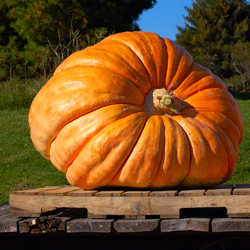Can you imagine growing a pumpkin over 1,000 lbs in your garden? How about over 2,000 lb? It’s possible to do. Last year, less than 50 miles south of here, a fellow named Tim Mathison set a new world’s record for the largest pumpkin when it weighed in at 2,032 lbs. at the Uesugi Farms Pumpkin Park Weigh-off in.
Interested in trying to beat his record? It only requires four elements: seed, soil, weather and LUCK!
Let’s start with the soil. Take several soil samples to your county extension agent or go online to search “soil sample testing” and add you county name. Generally, this is not expensive. Amend your soil with whatever nutrients the report shows are lacking. Also, be sure to add organic materials such as Bumper Crop or Gardeners Choice planting mix, to create light and well draining soil. Slightly acid soil encourages the best growth.
In the meantime, choose the seeds of the largest variety recommended for your region. Or, try to obtain seeds from a winning monster pumpkin grown in your area. Many growers hybridize their seeds for a number of years before producing a champion. Two popular varieties are Dill’s Atlantic Giant and Prizewinner, which are ancestors to many winners.
Start seeds indoors in April and transplant in mid-May into mounds 10′ wide and 1′ high. Remember, these plants can grow 30′ by 30′! Choose the sunniest and most protected location in the garden. During heavy rains or winds, protect with tarps. As the vines grow, cover the stems with soil. This develops roots along the stems to absorb additional water and nutrients.
To encourage strong growth, remove all tertiary growth. This leaves the main stem and secondary to produce flowers. The male flowers, developing first, have long stems. The female flowers have short stems with tiny pumpkins under the flower.
Most growers don’t leave pollination to chance. Here are the three steps to hand pollinate your pumpkin flowers:
- In early morning, remove the petals of the male flower
- Gently rub male stamen onto the female stigma to transfer pollen
- Gently tie the female flower petals closed
In the beginning of July, remove all pumpkins except the three best pumpkins on the main stem approximately 10′ from the main root. Two or three weeks later, remove the two slower growing pumpkins leaving the biggest and best shaped one. To prevent rot or decay, put something under it. A layer of sand may be used or a piece of plywood. As this pumpkin grows, remove any other developing “baby” pumpkins from the vine.
Prevent insect damage by clearing a 2′ radius around the pumpkin and dust with insecticide on a regular schedule. To prevent fungal leaf disease, do not let the leaves get wet in the evening unless they will have a chance to dry. Keep the area weeded to prevent competition for water and nutrients.
It may sound strange, but providing sun protection prevents splitting. When the summer sun becomes hot, cover the future winner with a sheet or erect a tarp over the pumpkin. This will also protect it from rain.
Monster pumpkins need a lot of water! Water them in the early evening allowing enough time for the surrounding surface soil to dry before nightfall. In the hot summer, they may require 1″ of water per week. Add liquid fertilizer to the irrigation weekly, or as often as the soil analysis requires.
Harvest your giant pumpkin when the weather becomes cold. With luck, you’ll need a number of friends or a back loader to bring it home. If yours is a winner, you may have to reward your friends for their labor, but this won’t be difficult. Tim Mathison earned over $15,000 with his winner!
Speaking of friends, growing giant pumpkins creates kinship between growers. On-line and social clubs frequently offer forums, information and seed exchanges and friendship for those with monster pumpkin goals. Check it out…and create your own MONSTER!







